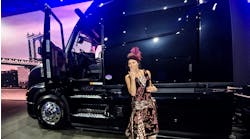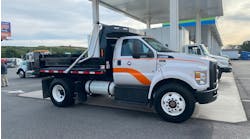Volvo reveals more on new "future-proof" VNL, teases electric model
DUBLIN, Virginia—With its safety features, fuel-efficient design, and its connectivity capability, the new Volvo VNL could become the safest, most fuel-efficient Class 8 truck on the market. The VNL platform was designed to be used in Volvo’s future trucks powered by alternative power systems, and while the truck has yet to make it into the hands of owners—deliveries begin in October—Volvo has already announced the next power system to be used in the all-new VNL.
Volvo offered a quick, distant look at the VNL Electric prototype at the close of a media event featuring a deep dive into the all-new VNL. A curtain hiding the vehicle lifted just long enough for media to take photos before lowering again, and Volvo executives took no questions.
What we know about the VNL Electric
Devoting only five sentences specifically about the VNL Electric in the announcement, the upcoming truck is shrouded in mystery. But here’s what we know:
See also: Volvo, Daimler Truck partner to standardize software-defined truck platform
Road to electrification
In February, shortly after the new VNL was announced, Fleet Maintenance's sister publication FleetOwner reported that the truck will be the platform for future Volvo power systems, “including battery-electric, fuel-cell electric, and renewables, as well as hydrogen.”
See more: What's new with the redesigned Volvo VNL? | Fleet Maintenance
The new generation VNL was developed and designed to be more competitive and more “future proof,” according to Magnus Koeck, VP of strategy, marketing, and brand management at Volvo Trucks North America. While Volvo announced the development of the VNL Electric before it even delivered the first ICE-powered VNL, it’s having this all-new ICE product in operations that could usher in the adoption of the VNL Electric and those additional alt-fuel and alt-power system vehicles.
Because the VNL was designed with future power system developments in mind, perhaps it’s this strategy that will help more fleets adjust to upcoming emissions regulations.
With federal Environmental Protection Agency rules and local and state regulations down the pipeline, the trucking industry is forced to adjust. Unfortunately, many fleets can’t make a business case for purchasing trucks with alternative powertrains as their costs are higher, and the time it takes to implement them could result in lost productivity. However, improvements to diesel-powered vehicles, even small, can make an impact on fleet efficiency and the environment.
Volvo has proved this with its all-new VNL, which has been 90% redesigned from the previous generation, resulting in a truck that’s 10% more fuel efficient. This could result in a savings of more than $5,000 per truck per year.
Volvo explained the math this way: Consider a truck has an annual mileage of 120,000 miles. A previous generation VNL truck gets 8 mpg, while the all-new VNL gets 8.8 mpg. This means a previous generation VNL will burn 15,000 gallons of fuel, whereas the new VNL will burn only 13,636, resulting in a savings of 1,364. If each gallon of fuel costs $4, that’s an annual savings of $5,456.
Further, adding a new VNL to their operations could give fleet owners a more probable taste of the future. Once Volvo’s VNL Electric is available, having an electric heavy-duty option built on the same platform and with similar features as a fleet's current vehicles could also simplify the transition to EVs.
This article was originally published on FleetOwner.com.





